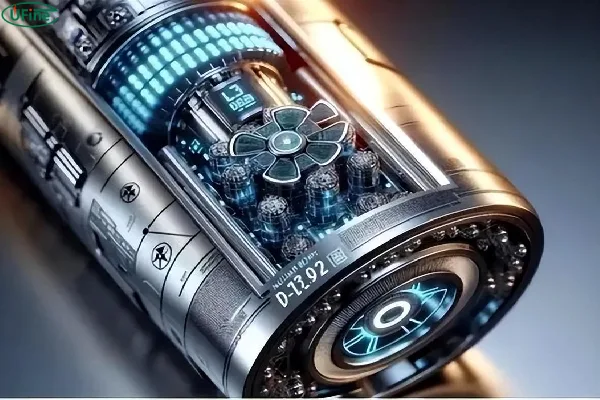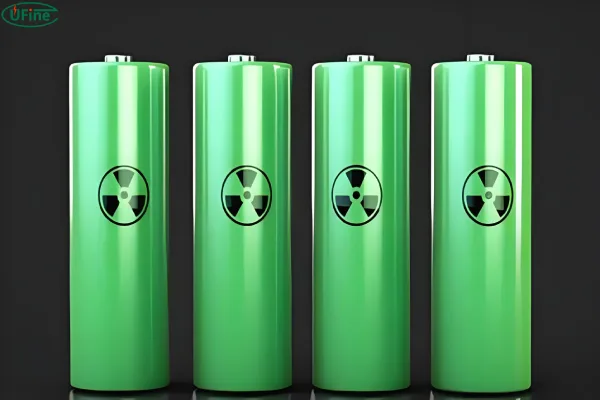
- Part 1. What is an atomic battery?
- Part 2. Who invented the atomic battery?
- Part 3. Comparison of atomic batteries with li-ion, NiMH, and lead batteries
- Part 4. Advantages and disadvantages of atomic battery
- Part 5. How has the atomic battery impacted society today?
- Part 6. Current development of atomic battery
Part 1. What is an atomic battery?
How does an atomic battery (nuclear battery) work?
An atomic battery, also known as a nuclear battery or a radioisotope thermoelectric generator (RTG), generates electricity using energy released from the decay of radioactive isotopes. Unlike traditional batteries, which rely on chemical reactions, atomic batteries convert heat produced by the decay process into electricity. This heat is converted using a thermoelectric material, often based on the Seebeck effect, which generates an electric current from a temperature difference.
Atomic batteries are unique in that they can last for many years, even decades, without needing to be replaced or recharged. This longevity makes them invaluable in certain fields where replacing or recharging batteries would be difficult or impossible, such as deep space exploration, remote scientific research stations, or medical implants.
Part 2. Who invented the atomic battery?
The development of atomic batteries dates back to the early 20th century. In 1913, British physicist Henry Moseley first proposed the idea of converting the energy from radioactive decay into electrical energy. However, it wasn’t until the 1950s that practical atomic batteries began to take shape.
During the Cold War, the United States Atomic Energy Commission (AEC) began to focus on harnessing nuclear energy for more practical, peaceful purposes. The first working atomic batteries were developed in this period to power military equipment and spacecraft. The U.S. Space Program and NASA were particularly interested in atomic batteries for their ability to provide long-term, reliable energy in environments where solar power could not be used.
The most significant breakthrough came with the development of radioisotope thermoelectric generators (RTGs), which became the backbone of many space missions. The Voyager spacecraft, launched in 1977 and still operational today, is one of the most famous examples of a space mission relying on an RTG to power its systems for over four decades.
Who Invented the Lithium-Ion Battery
Part 3. Comparison of atomic batteries with li-ion, NiMH, and lead batteries
Atomic batteries and modern battery technologies each have unique characteristics tailored to specific applications. Below is a detailed comparison between atomic batteries and major commercial battery types, including lithium-ion, nickel-metal hydride (NiMH), and lead-acid batteries.
1. Energy Density and Longevity
- Atomic Batteries:
Atomic batteries have an extraordinarily high energy density and can operate for decades without recharging, thanks to their reliance on radioactive decay. This makes them ideal for long-term, maintenance-free applications like spacecraft and remote scientific instruments. - Lithium-Ion Batteries:
Lithium-ion batteries offer high energy density and are rechargeable, making them the go-to choice for consumer electronics, electric vehicles, and renewable energy storage. However, they degrade over time and typically last only a few years. - Nickel-Metal Hydride (NiMH) Batteries:
NiMH batteries have a moderate energy density and are rechargeable, with a lifespan shorter than lithium-ion batteries. They are primarily used in hybrid vehicles and certain household electronics. - Lead-Acid Batteries:
Lead-acid batteries have a relatively low energy density and shorter lifespan but are cost-effective and widely used for automotive starters, backup power systems, and industrial applications.
Winner: Atomic batteries lead in energy density and longevity but are unsuitable for general-purpose use due to their radioactive nature.
2. Power Output
- Atomic Batteries:
These batteries provide a steady, low-power output over extended periods. This makes them unsuitable for applications requiring high, immediate energy demands, such as electric vehicles or heavy machinery. - Lithium-Ion Batteries:
Lithium-ion batteries excel in providing high power output, making them versatile for high-demand devices like smartphones, laptops, and EVs. - Nickel-Metal Hydride Batteries:
NiMH batteries also offer a reasonable power output but cannot match the performance of lithium-ion batteries. - Lead-Acid Batteries:
Lead-acid batteries can provide high surge currents, making them suitable for applications like vehicle ignition and emergency power systems.
Winner: Lithium-ion and lead-acid batteries outperform atomic batteries in delivering high power output.
3. Environmental Impact
- Atomic Batteries:
These batteries use radioactive materials, raising significant concerns about disposal and potential environmental contamination. Strict regulations are required to handle them safely. - Lithium-Ion Batteries:
Lithium-ion batteries pose challenges due to their reliance on finite resources like lithium and cobalt, and improper disposal can lead to environmental damage. However, recycling initiatives are improving. - Nickel-Metal Hydride Batteries:
NiMH batteries are less harmful to the environment than lithium-ion batteries, as they do not rely on heavy metals like cobalt. However, their production still has environmental costs. - Lead-Acid Batteries:
While highly recyclable, lead-acid batteries pose significant environmental risks if not properly managed due to their toxic lead content.
Winner: NiMH batteries are relatively more eco-friendly, but none of the batteries, including atomic batteries, are entirely free from environmental concerns.
4. Cost
- Atomic Batteries:
Atomic batteries are extremely expensive to produce due to the use of radioactive materials and the specialized technology required. They are only economically viable for niche applications like space exploration. - Lithium-Ion Batteries:
Lithium-ion batteries are becoming more affordable with advancements in manufacturing and economies of scale, though they are still costlier than older technologies like lead-acid. - Nickel-Metal Hydride Batteries:
NiMH batteries are moderately priced and less expensive than lithium-ion batteries but are being phased out for many applications. - Lead-Acid Batteries:
Lead-acid batteries are the most cost-effective, making them popular for budget-sensitive applications.
Winner: Lead-acid batteries are the cheapest option, while atomic batteries are the most expensive.
5. Applications
- Atomic Batteries:
Ideal for long-term, low-maintenance applications in extreme environments, such as space probes, pacemakers (historically), and remote sensors. - Lithium-Ion Batteries:
Dominant in consumer electronics, electric vehicles, and renewable energy systems due to their high energy density and rechargeability. - Nickel-Metal Hydride Batteries:
Common in hybrid vehicles and some household electronics, though being replaced by lithium-ion. - Lead-Acid Batteries:
Used in automotive starters, uninterruptible power supplies (UPS), and large-scale energy storage.
Winner: Each battery type excels in its respective niche, but lithium-ion batteries are the most versatile.
Summary Table
| Feature | Atomic Batteries | Lithium-Ion Batteries | NiMH Batteries | Lead-Acid Batteries |
|---|---|---|---|---|
| Energy Density | Extremely High | High | Moderate | Low |
| Longevity | Decades | 2–5 years | 2–3 years | 1–3 years |
| Power Output | Low | High | Moderate | High |
| Environmental Impact | High (radioactive waste) | Moderate (recycling needed) | Lower than Li-ion | High (toxic lead) |
| Cost | Very High | Moderate | Moderate | Low |
| Applications | Niche | Versatile | Limited | Budget-sensitive |
A Complete History of Lithium-ion Batteries
Part 4. Advantages and disadvantages of atomic battery
Atomic batteries offer several compelling advantages, but they are not without drawbacks. Let’s explore both sides in detail.
Advantages:
- Longevity: One of the primary benefits of atomic batteries is their extremely long lifespan. These batteries can last anywhere from 10 to 100 years, depending on the isotope used. This makes them perfect for long-term applications like space missions or medical devices.
- Consistent Power Output: Unlike chemical batteries, which degrade over time and lose their ability to hold a charge, atomic batteries provide a constant energy output until the radioactive material is fully depleted.
- No Need for Maintenance: Since atomic batteries have no moving parts and rely on natural radioactive decay, they are incredibly durable and require little to no maintenance. This is particularly useful in remote or hard-to-reach locations.
- High Energy Density: Atomic batteries have a much higher energy density compared to traditional batteries, meaning they can store more energy in a smaller space.
- Compact Size: Despite their high energy capacity, atomic batteries are generally small and lightweight, making them ideal for applications where space is limited.
Disadvantages:
- Radioactivity: The use of radioactive materials raises safety concerns. Although atomic batteries are designed to be safe, improper handling or disposal could lead to radiation exposure.
- High Cost: Developing and manufacturing atomic batteries is expensive due to the use of specialized materials and complex technology. This makes them impractical for everyday consumer products.
- Limited Applications: Because of the use of radioactive substances and high costs, atomic batteries are restricted to specialized fields like space exploration, military applications, and certain medical devices.
- Environmental Impact: While atomic batteries are generally safe when used correctly, there are concerns about their long-term environmental impact, especially when it comes to disposing of radioactive materials.
Part 5. How has the atomic battery impacted society today?
The atomic battery (nuclear battery ) is a specialized energy source that uses radioactive decay to generate electricity. Although not widely used for everyday applications due to its unique characteristics, it has had significant impacts on modern society, particularly in niche sectors. Here’s how it has made a difference:
1. Advancements in Space Exploration
- Reliable Power in Extreme Conditions:
Atomic batteries are a critical component of space exploration. They power spacecraft, rovers, and satellites in environments where solar power is inefficient or unavailable, such as deep space or shadowed regions on the Moon or Mars.- Example: NASA’s Voyager probes, launched in 1977, are still operational today, thanks to radioisotope thermoelectric generators (RTGs).
- Longevity:
Their long lifespan, often exceeding decades, ensures uninterrupted operation of missions far from Earth.
2. Medical Applications
- Pacemakers and Medical Devices:
In the past, atomic batteries were used in heart pacemakers, providing patients with a reliable energy source for years. While modern pacemakers now use rechargeable lithium-ion batteries, the early use of nuclear batteries extended the lifespan and improved the reliability of these devices. - Radiopharmaceuticals Development:
By leveraging similar principles, the development of nuclear energy sources has also contributed indirectly to advancements in diagnostic and therapeutic applications in nuclear medicine.
3. Military and Defense Applications
- Remote Monitoring and Surveillance:
Atomic batteries power remote sensors, underwater detection systems, and monitoring equipment that require long-term, maintenance-free energy solutions. - Miniaturized Electronics:
The technology has spurred innovation in creating compact power sources for critical military applications.
4. Scientific Research
- Remote Scientific Stations:
Atomic batteries power instruments in remote and extreme environments, such as polar research stations or deep-sea exploration devices. - Data Collection:
Their use in monitoring systems, such as seismic sensors, enables long-term environmental and geological data collection.
5. Energy Technology Innovations
- Inspiration for Battery Development:
While atomic batteries themselves are not used in consumer electronics, their development has influenced research into long-lasting and high-efficiency energy storage solutions, particularly for challenging environments. - Potential Future Applications:
With growing interest in sustainable and long-lasting energy sources, atomic batteries may play a role in future renewable energy systems or microgrid applications.
Societal Considerations
- Safety Concerns:
The use of radioactive materials raises safety and environmental concerns, limiting the widespread adoption of atomic batteries. - Ethical and Regulatory Challenges:
Stringent regulations govern the use and disposal of radioactive materials, ensuring that these technologies are used responsibly.
Part 6. Current development of atomic battery
In recent years, the development of atomic batteries has shifted focus toward improving efficiency and reducing safety concerns. Research is ongoing into better thermoelectric materials that can convert heat into electricity more effectively. Additionally, scientists are exploring betavoltaic batteries, which use the energy from beta particles emitted by radioactive decay to generate power. These batteries are expected to be smaller and safer than RTGs, opening up new applications in medical devices, sensors, and other small-scale technologies.
Related Tags:
More Articles

Big Square Battery Safety Standards You Must Know
Learn key safety standards for big square batteries to avoid fire risks, shipping delays, and compliance issues in EV, industrial, and energy storage projects.
Big Square Battery Applications in Solar & Industrial Equipment
Big square batteries deliver high capacity, stable output, and long life for solar, industrial, and backup power. Explore key uses and advantages.
Big Square Battery vs Cylindrical Battery: Complete 2025 Guide for EVs, ESS & Industrial Devices
Choosing the right battery is key for designers and engineers. Compare big square vs cylindrical batteries to find the best fit for your application.
How to Choose the Right Big Square Battery for Your Device?
If you’re choosing a big square battery for EVs, solar, or mobility devices, this guide helps you pick the right solution for real-world needs.
Big Square Battery Complete Guide: Types, Uses & Buying Tips
If you are choosing a big square lithium battery for EVs, solar, RVs, or AGVs, this guide helps you select the right NMC, LFP, or LTO solution with examples.





